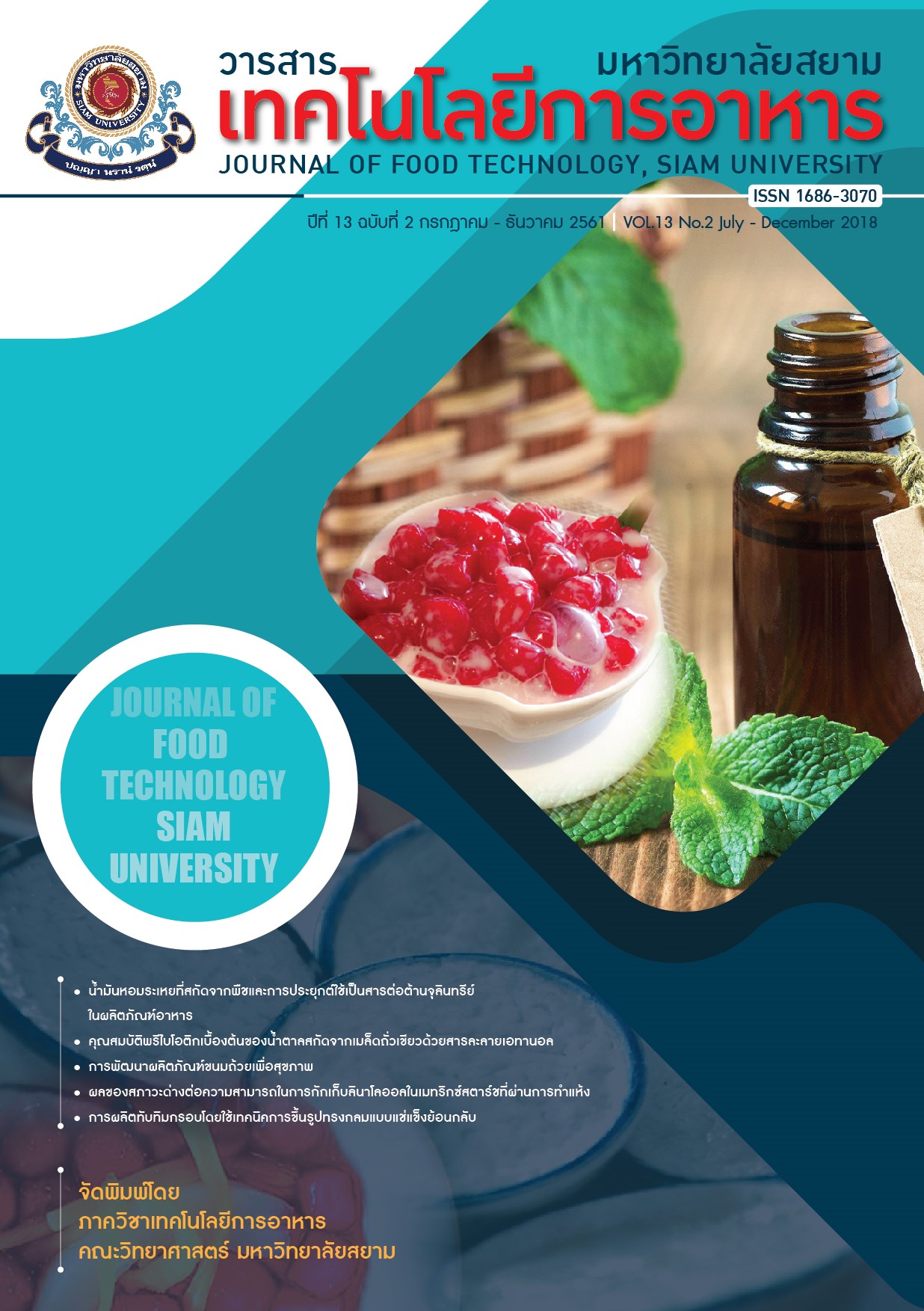Essential Oils from Plant Extracts and Theirs Application as Antimicrobial Agents in Food Products
Main Article Content
Abstract
Essential oils are natural aroma compounds from plants, herbs, and spices, with biological activity as antimicrobial agents and have been exploited as natural preservatives in food products. There are many reports which highlighted the efficiency of essential oils against food spoilage, food pathogen, and molds. The latter is considered as the pathogen responsible for postharvest decay of agricultural products and causes severe economic losses. The usage limit of essential oils in food products is caused by rapidly evaporating and strong flavor of essential oils. The above-mentioned limitation of essential oils are pleading for the application of methods and technology in order to improve the efficiency of essential oils and have led to an interest in the use of essential oils as potential alternative natural antimicrobial agents in food products for ensuring food safety as the consumer concerns.
Article Details
Copyrights of all articles in the Journal of Food Technology available in print or online are owned by Siam University and protected by law.
References
[2] Attokaran, M. (2011). Natural Food Flavors and Colorants. Wiley-Blackwell, IFT Press, USA.
[3] Jayasena, D.D. and Jo, C. (2013). Essential oils as potential antimicrobial agents in meat and meat products: A review. Trends in Food Science and Technology. 34(2): 96-108.
[4] Sruamsiri, P., Srisai, K., Chaichana, P. and Pongchanta, W. (2005). Complete report of the Royal Project foundation: Development of processing herbs. The Royal Project foundation.
[5] Matan, N., Saengkrajang, W. and Matan, N. (2011). Antifungal activities of essential oils applied by dip-treatment on area palm (Areca catechu) leaf sheath and persistence of potency upon storage. International Biodeterioration and Biodegradation. 65(1): 212-216.
[6] Songsamoe, S., Matan, N. and Matan, N. (2016). Effect of UV-C radiation and vapor released from a water hyacinth root absorbent containing bergamot oil to control mold on storage of brown rice. Journal of Food Science and Technology. 53(3): 1445-1453.
[7] USFDA. (2017). Code of Federal Regulations Title 21 Volume 3: 21 CFR 182.20 Essential oils, oleoresins (solvent-free), and natural extractives (including distillates). Revised as of April 1, 2017. U.S. Food and Drug Administration.
[8] Calo, J.R., Crandall, P., O’Bryan, C.A. and Ricke, S.C. (2015). Essential oils as antimicrobials in food system: A review. Food Control. 54: 111-119.
[9] Fathi, E. and Sefidkon, F. (2012). Influence of drying and extraction methods on yield and chemical composition of the essential oil of Eucalyptus sargentii. Journal of Agricultural Science and Technology. 14(5): 1035-1042.
[10] Atares, L. and Chiralt, A. (2016). Review: Essential oil as additives in biodegradable films and coating for active food packaging. Trends in Food Science and Technology. 48: 51-62.
[11] Goni, P. Lopez, P. Sanchez, C., Gomez-Lus, R., Beoerril, R. and Nerine, C. (2009). Antimicrobial activity in the vapour phase of a combination of cinnamon and clove essential oils. Food Chemistry. 116(4): 982-989.
[12] Ouattara, R.E.S., Holley, R.A., Piette, G.J.P. and Begin, A. (1997). Antibacterial activity of selected fatty acids and essential oils against six meat spoilage organisms. International Journal of Food Microbiology. 37(2-3): 155-162.
[13] Karabagias, I., Badeka, A. and Kontominas, M.G. (2011). Shelf life extension of lamb meat using thyme or oregano essential oils and modified atmosphere packaging. Meat Science. 88(1): 109-116.
[14] Solomakos, N., Govaris, A., Koidis, P. and Botsoglou, N. (2008). The antimicrobial effect of thyme essential oil, nisin and their combination against Escherichia coli O157: H7 in minced beef during refrigerated storage. Meat Science. 80(2): 159-166.
[15] Fratianni, F. Martino, L.D., Melone, A., Feo, V.D., Coppola, R. and Nazzaro, F. (2010). Preservation of chicken breast meat treated with thyme and balm essential oils. Journal of Food Science. 75(8): 528-535.
[16] Riznar, K., Celan, S., Knez, Z., Skerget, M., Bauman, D. and Glaser, R. (2006). Antioxidant and antimicrobial activity of rosemary extract in chicken frankfurters. Journal of Food Science. 71(7): C425-C429.
[17] Passarinho, A.T.P., Dias, N.F., Camilloto, G.P., Cruz, R.S., Otoni, C.G., Moraes, A.R.F. and Soares, N. De F.F. (2014). Sliced bread preservation through oregano essential oil-containing sachet. Journal of Food Process Engineering. 37(1): 53-62.
[18] Prakash, B. Kujur, A., Yadav, A., Kumar, A., Singh, P.P. and Dubey, N.K. (2018). Nanoencapsulation: An efficient technology to boost the antimicrobial potential of plant essential oils in food system. Food Control. 89: 1-11.
[19] Rattanapitigorn, P., Arakawa, M. and Tseuro, M. (2006). Vanillin enhances the antifungal effect of plant essential oils against Botrytis cinerea. The International Journal of Aromatherapy. 16(3): 193-198.
[20] Cassella, S. Cassella, J. and Smith, I. (2002). Synergistic antifungal activity of tea tree (Melaleuca alternifolia) and lavender (Lavandula angustifolia) essential oil against dermatophyte infection. International Journal of Aromatherapy. 12(1): 2-15.
[21] Pan, K., Chen, H., Davidson, P.M. and Zhong, Q. (2014). Thymol nanoencapsulatated by sodium caseinate: Physical and antilisterial properties. Journal of Agricultural and Food Chemistry. 62(7): 1649-1657.


